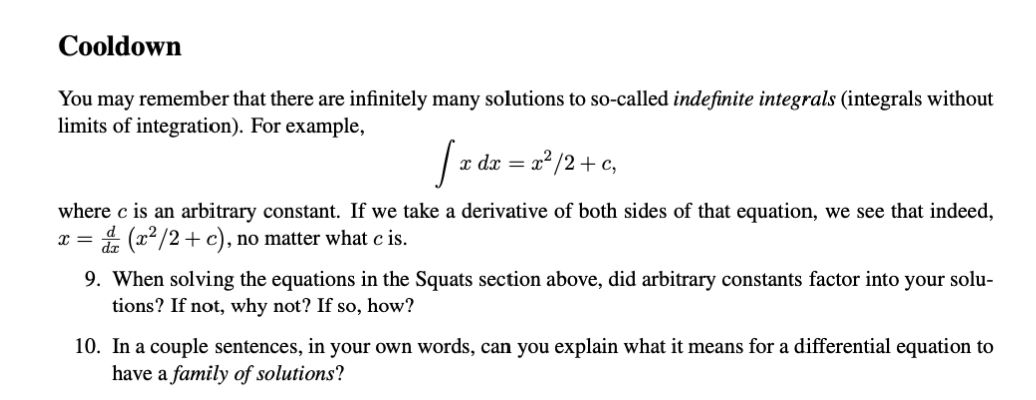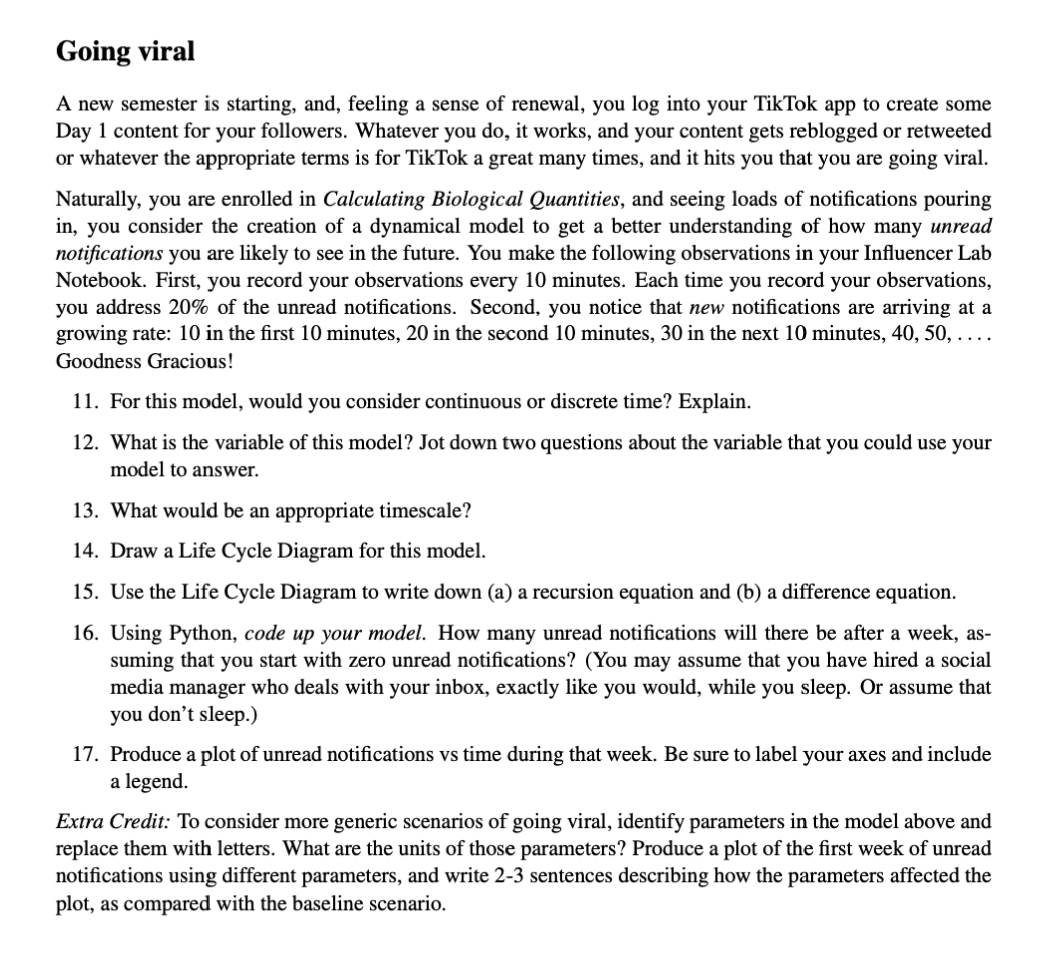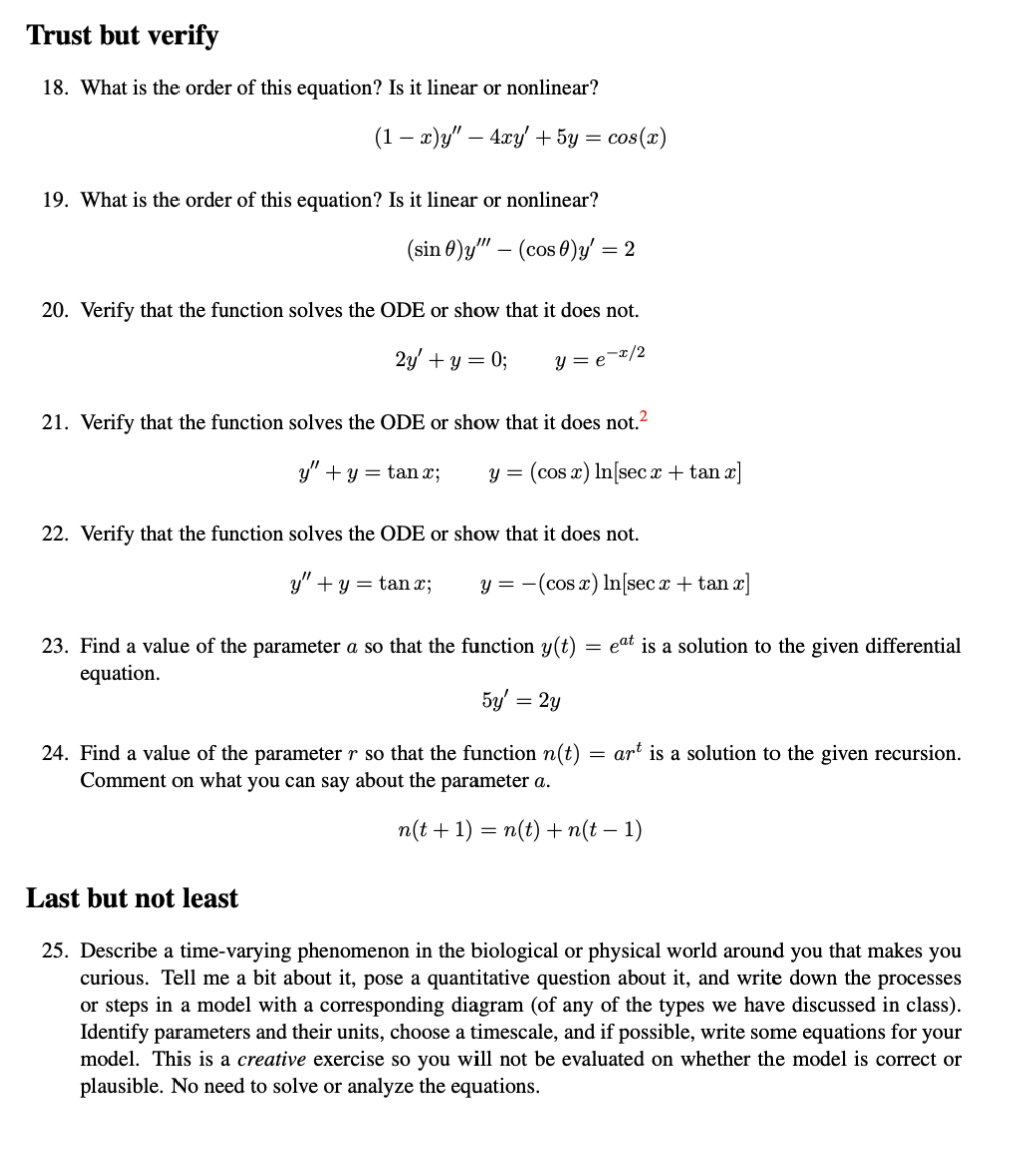


Cooldown You may remember that there are infinitely many solutions to so-called indefinite integrals (integrals without limits of integration). For example, x dx = x2/2+c, Jade = where c is an arbitrary constant. If we take a derivative of both sides of that equation, we see that indeed, di (22/2+c), no matter what c is. 9. When solving the equations in the Squats section above, did arbitrary constants factor into your solu- tions? If not, why not? If so, how? 10. In a couple sentences, in your own words, can you explain what it means for a differential equation to have a family of solutions? Going viral A new semester is starting, and, feeling a sense of renewal, you log into your TikTok app to create some Day 1 content for your followers. Whatever you do, it works, and your content gets reblogged or retweeted or whatever the appropriate terms is for TikTok a great many times, and it hits you that you are going viral. Naturally, you are enrolled in Calculating Biological Quantities, and seeing loads of notifications pouring in, you consider the creation of a dynamical model to get a better understanding of how many unread notifications you are likely to see in the future. You make the following observations in your Influencer Lab Notebook. First, you record your observations every 10 minutes. Each time you record your observations, you address 20% of the unread notifications. Second, you notice that new notifications are arriving at a growing rate: 10 in the first 10 minutes, 20 in the second 10 minutes, 30 in the next 10 minutes, 40, 50, .... Goodness Gracious! 11. For this model, would you consider continuous or discrete time? Explain. 12. What is the variable of this model? Jot down two questions about the variable that you could use your model to answer. 13. What would be an appropriate timescale? 14. Draw a Life Cycle Diagram for this model. 15. Use the Life Cycle Diagram to write down (a) a recursion equation and (b) a difference equation. 16. Using Python, code up your model. How many unread notifications will there be after a week, as- suming that you start with zero unread notifications? (You may assume that you have hired a social media manager who deals with your inbox, exactly like you would, while you sleep. Or assume that you don't sleep.) 17. Produce a plot of unread notifications vs time during that week. Be sure to label your axes and include a legend. Extra Credit: To consider more generic scenarios of going viral, identify parameters in the model above and replace them with letters. What are the units of those parameters? Produce a plot of the first week of unread notifications using different parameters, and write 2-3 sentences describing how the parameters affected plot, as compared with the baseline scenario. Trust but verify 18. What is the order of this equation? Is it linear or nonlinear? (1 x)y" 4xy' +5y = cos(x) 19. What is the order of this equation? Is it linear or nonlinear? (sin 6)y" (cos 6)y = 2 20. Verify that the function solves the ODE or show that it does not. 2y' +y=0; y=e-2/2 21. Verify that the function solves the ODE or show that it does not.2 y" + y = tan x; y=(cos x) In[sec x + tan x] 22. Verify that the function solves the ODE or show that it does not. y"+y=tanx; y=-(cos x) In[sec x + tan x] eat is a solution to the given differential 23. Find a value of the parameter a so that the function y(t) equation. 54' = 2y art is a solution to the given recursion. 24. Find a value of the parameter r so that the function n(t) Comment on what you can say about the parameter a. n(t+1) = m(t) + m(t - 1) Last but not least 25. Describe a time-varying phenomenon in the biological or physical world around you that makes you curious. Tell me a bit about it, pose a quantitative question about it, and write down the processes or steps in a model with a corresponding diagram (of any of the types we have discussed in class). Identify parameters and their units, choose a timescale, and if possible, write some equations for your model. This is a creative exercise so you will not be evaluated on whether the model is correct or plausible. No need to solve or analyze the equations. Cooldown You may remember that there are infinitely many solutions to so-called indefinite integrals (integrals without limits of integration). For example, x dx = x2/2+c, Jade = where c is an arbitrary constant. If we take a derivative of both sides of that equation, we see that indeed, di (22/2+c), no matter what c is. 9. When solving the equations in the Squats section above, did arbitrary constants factor into your solu- tions? If not, why not? If so, how? 10. In a couple sentences, in your own words, can you explain what it means for a differential equation to have a family of solutions? Going viral A new semester is starting, and, feeling a sense of renewal, you log into your TikTok app to create some Day 1 content for your followers. Whatever you do, it works, and your content gets reblogged or retweeted or whatever the appropriate terms is for TikTok a great many times, and it hits you that you are going viral. Naturally, you are enrolled in Calculating Biological Quantities, and seeing loads of notifications pouring in, you consider the creation of a dynamical model to get a better understanding of how many unread notifications you are likely to see in the future. You make the following observations in your Influencer Lab Notebook. First, you record your observations every 10 minutes. Each time you record your observations, you address 20% of the unread notifications. Second, you notice that new notifications are arriving at a growing rate: 10 in the first 10 minutes, 20 in the second 10 minutes, 30 in the next 10 minutes, 40, 50, .... Goodness Gracious! 11. For this model, would you consider continuous or discrete time? Explain. 12. What is the variable of this model? Jot down two questions about the variable that you could use your model to answer. 13. What would be an appropriate timescale? 14. Draw a Life Cycle Diagram for this model. 15. Use the Life Cycle Diagram to write down (a) a recursion equation and (b) a difference equation. 16. Using Python, code up your model. How many unread notifications will there be after a week, as- suming that you start with zero unread notifications? (You may assume that you have hired a social media manager who deals with your inbox, exactly like you would, while you sleep. Or assume that you don't sleep.) 17. Produce a plot of unread notifications vs time during that week. Be sure to label your axes and include a legend. Extra Credit: To consider more generic scenarios of going viral, identify parameters in the model above and replace them with letters. What are the units of those parameters? Produce a plot of the first week of unread notifications using different parameters, and write 2-3 sentences describing how the parameters affected plot, as compared with the baseline scenario. Trust but verify 18. What is the order of this equation? Is it linear or nonlinear? (1 x)y" 4xy' +5y = cos(x) 19. What is the order of this equation? Is it linear or nonlinear? (sin 6)y" (cos 6)y = 2 20. Verify that the function solves the ODE or show that it does not. 2y' +y=0; y=e-2/2 21. Verify that the function solves the ODE or show that it does not.2 y" + y = tan x; y=(cos x) In[sec x + tan x] 22. Verify that the function solves the ODE or show that it does not. y"+y=tanx; y=-(cos x) In[sec x + tan x] eat is a solution to the given differential 23. Find a value of the parameter a so that the function y(t) equation. 54' = 2y art is a solution to the given recursion. 24. Find a value of the parameter r so that the function n(t) Comment on what you can say about the parameter a. n(t+1) = m(t) + m(t - 1) Last but not least 25. Describe a time-varying phenomenon in the biological or physical world around you that makes you curious. Tell me a bit about it, pose a quantitative question about it, and write down the processes or steps in a model with a corresponding diagram (of any of the types we have discussed in class). Identify parameters and their units, choose a timescale, and if possible, write some equations for your model. This is a creative exercise so you will not be evaluated on whether the model is correct or plausible. No need to solve or analyze the equations









